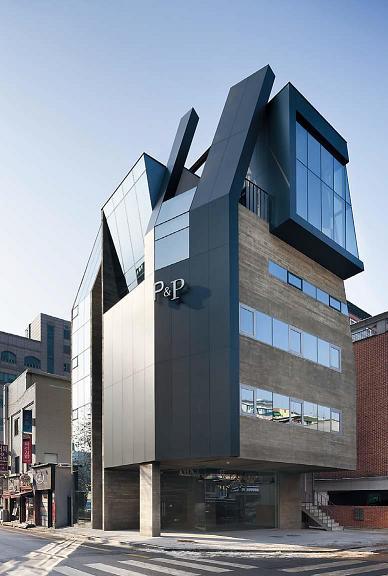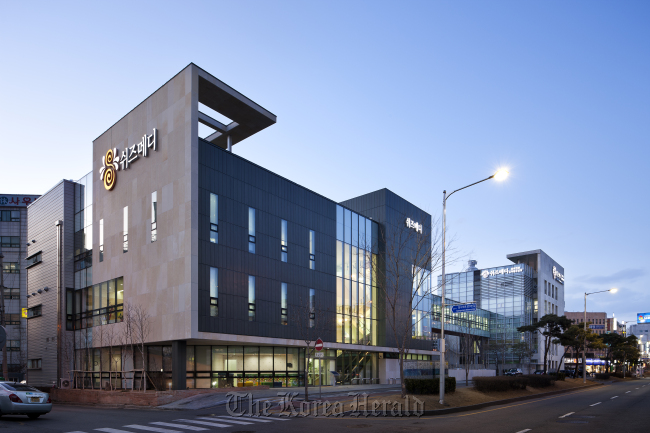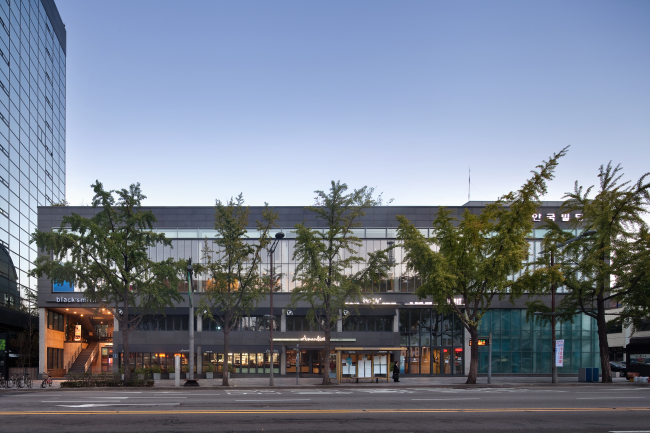Changing cityscape: Giving old buildings a new look
Low-rise commercial buildings remodeled with stylish designs
By Lee Woo-youngPublished : Feb. 21, 2013 - 19:23
Seoul’s cityscape represents the rapid economic growth of Korea. The city exhibits various architectural scenes from high-rise office buildings, massive apartment complexes and retail spaces to buildings from both old and modern days.
While some trendy streets of Seoul such as Garosu-gil and Hongdae give off a sophisticated ambience, most of the small streets, defined by narrow pedestrian walks with mundane or showy buildings, constitute an ugly side of the city.
“There are many old buildings and buildings that ruin the cityscape,” said Kim Sun-hyun, cohead of DLIM, an architectural group in Korea. “Maybe we need to start with commercial buildings to change the cityscape.”
“But it’s usually the building owners’ wish to maximize the use of space while on a limited budget that creates such unaesthetic designs. Most of the time their final goal is to create as much space as possible within the range where architecture law and budget allows,” Kim explained.
Her architecture team completed the construction of a five-story building in the underdeveloped neighborhood of Gangdong district in eastern Seoul last December.
While some trendy streets of Seoul such as Garosu-gil and Hongdae give off a sophisticated ambience, most of the small streets, defined by narrow pedestrian walks with mundane or showy buildings, constitute an ugly side of the city.
“There are many old buildings and buildings that ruin the cityscape,” said Kim Sun-hyun, cohead of DLIM, an architectural group in Korea. “Maybe we need to start with commercial buildings to change the cityscape.”
“But it’s usually the building owners’ wish to maximize the use of space while on a limited budget that creates such unaesthetic designs. Most of the time their final goal is to create as much space as possible within the range where architecture law and budget allows,” Kim explained.
Her architecture team completed the construction of a five-story building in the underdeveloped neighborhood of Gangdong district in eastern Seoul last December.

Initially requested to conduct remodeling, Kim decided to go for building from scratch due to some structural problems. She was able to satisfy her client by securing bigger building space and with a design that can outlast others.
The building is designed to use sunlight where it is needed and to secure privacy between residents and office workers. It has a rooftop garden where people can take work breaks.
It also became an iconic structure of the area with the modern, sturdy-looking exterior.
“The district office said they would like to see such an iconic building in the neighborhood and wanted to put a building picture in the lobby of the district office,” said Kim.

Her architecture team remodeled a warehouse into a hospital in Suwon in Gyeonggi Province, which won them the Korean Architecture Award in 2012. Instead of tearing down the existing structure, Kim chose to remodel, which she believed was the most effective and environmentally sustainable way.
“I think more people will choose remodeling of existing buildings in the future rather than demolishing old ones. Remodeling doesn’t mean a lower budget or shorter construction period. It takes more effort because one has to understand the existing structure first. But in the long run, one needs to consider what will be sustainable,” said Kim.
Anguk Building is another example of changing the old view of the city.
Located in the middle of historical spots of Seoul, the 30-year-old Anguk Building was remodeled to make it more accessible to visitors, including foreign tourists visiting nearby attractions such as Insa-dong, Samcheong-dong and Bukchon.
“I think more people will choose remodeling of existing buildings in the future rather than demolishing old ones. Remodeling doesn’t mean a lower budget or shorter construction period. It takes more effort because one has to understand the existing structure first. But in the long run, one needs to consider what will be sustainable,” said Kim.
Anguk Building is another example of changing the old view of the city.
Located in the middle of historical spots of Seoul, the 30-year-old Anguk Building was remodeled to make it more accessible to visitors, including foreign tourists visiting nearby attractions such as Insa-dong, Samcheong-dong and Bukchon.

“The building located in such an important spot was not being used properly. The rental fee of the second and third floor was so cheap, but most of the spaces in the upper floors weren’t even being used,” said Lee Ki-ok, head of Phillip Architects in Seoul, which completed the remodeling project in 2010.
The four-story building features portions of roof tile arrangements found on traditional Korean housing for its front window. It helps the building blend well into the atmosphere of the traditional neighborhood. The building has coffee shops, a restaurant and other sites that people frequently stop by.
“We created a more open storefront with an inviting atmosphere so that people can easily go in and out of the restaurant on the second floor,” said Lee.
Architect Kim Paik-sun said one needs to find the middle ground, which can satisfy both residents and architects when changing existing buildings and landscape.
“I still find old alleys of my neighborhood intriguing. But that’s when I look at from the visitor’s perspective. You don’t know what people living in the area think about the same alley you are looking at,” said Kim.
By Lee Woo-young (wylee@heraldcorp.com)
















![[KH Explains] Hyundai's full hybrid edge to pay off amid slow transition to pure EVs](http://res.heraldm.com/phpwas/restmb_idxmake.php?idx=652&simg=/content/image/2024/04/18/20240418050645_0.jpg&u=20240418181020)

![[Today’s K-pop] Zico drops snippet of collaboration with Jennie](http://res.heraldm.com/phpwas/restmb_idxmake.php?idx=642&simg=/content/image/2024/04/18/20240418050702_0.jpg&u=)